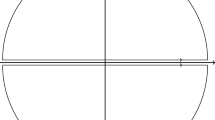Abstract
It is widely recognized that for highly unstable dynamical systems there exists a fundamental limitation on predictability and determinism. An important class of such highly unstable systems is the class of K-flow, which is further characterized by the existence of time-asymmetric objects in the form of K-partition. Our recent approach to the problem of irreversibility has shown that when the implications of the limitation on determinism arising from strong form of instability and those of the existence of K-partition are consistently taken into account, one is naturally led from the physically unrealizable deterministic evolution of phase points to an entropy-increasing stochastic Markovian evolution. Furthermore, this transition is not the result of extraneously imposed coarse graining and/or approximation schemes, but can be brought about by an invertible transformation whose existence and construction are determined by the nature of the instability of the dynamical system itself. After a brief review of this theory which also contains some relatively new remarks, we prove that classical Klein-Gordon field (both massive and massless) possess the structure of K-flow. This seems to provide the first examples of relativistic systems that are K-flows. Some of the implications of this result are briefly discussed. From a mathematical point of view, this seems to be a first step toward an ergodic theory of partial differential equations. In the process, we also provide an independant group-theoretic proof of the existence of incoming and outgoing subspaces of the scattering theory of Lax and Phillips for the wave equation.
Similar content being viewed by others
References
J. Lighthill,Proc. R. Soc. Lond. A 407:35–50 (1986).
R. P. Feynman,The Feynman Lectures on Physics, Vol. III (Addison-Wesley, Reading, Massachusetts, 1965).
B. Misra,Proc. Natl. Acad. Sci. USA 75:1627–1631 (1978).
B. Misra, I. Prigogine, and M. Courbage,Physica 98A:l-26 (1979).
B. Misra, inQuantum Mechanics in Mathematics, Chemistry and Physics, K. Gustafson and W. Reinhardt, eds. (Plenum Press, 1981), pp. 495–502.
B. Misra and I. Prigogine,Prog. Theor. Phys. (Suppl.) 69:101–110 (1980).
S. Goldstein, B. Misra, and M. Courbage,J. Stat. Phys. 25:111–125 (1981).
B. Misra and I. Prigogine, inLong-Time Prediction in Dynamics, C. Horton, Jr., L. Reichl, and V. Szebehely, eds. (Wiley, New York, 1983), pp. 21–43.
I. Prigogine and M. Courbage,Proc. Natl. Acad. Sci. USA 80:2412–2416 (1983).
B. Misra and I. Prigogine,Lett. Math. Phys. 7:421–429 (1983).
Y. Elskens and I. Prigogine,Proc. Natl. Acad. Sci. USA 83:5756–5760 (1986).
R. Goodrich, K. Gustafson, and B. Misra,Physica A 102:379–388 (1980).
R. Goodrich, K. Gustafson, and B. Misra,J. Stat. Phys. 43:317–320 (1986).
B. Misra, I. Prigogine, and M. Courbage,Proc. Natl. Acad. Sci. USA 76:4768–4772 (1979).
C. Lockhart and B. Misra,Physica 136A:47–76 (1986).
M. Spohn,Rev. Mod. Phys. 53:569–615.
I. Prigogine, C. George, F. Hénin, and L. Rosenfeld,Chem. Sci. 4:5–32 (1973).
C. Lockhart, B. Misra, and I. Prigogine,Phys. Rev. D 25:921–929 (1982).
Y. Sinaï,Sov. Math. Dokl. 4:1818–1822 (1963).
Y. Sinaï,Uspekhi Mat. Nauk. 27:137 (1972).
G. Gallavotti and D. Ornstein,Commun. Math. Phys. 38:83–101 (1974).
U. M. Titulaer,Physica 70:456–476 (1973).
O. Lanford and J. Lebowitz, inLecture Notes in Physics, No. 38 (1975), p. 144.
J. L. Van Hemmen,Phys. Rep. 65(2):43–149 (1980).
D. Anosov,Proc. Steklov Inst., No. 90 (1967).
Y. Sinaï,Sov. Math. Dokl. 1:335 (1960).
I. Arnold and A. Avez,Ergodic Problems of Classical Mechanics(Benjamin, 1968).
I. Cornfeld, S. Fomin, and Y. Sinaï,Ergodic Theory (Springer, 1982).
R. Bahadur,Proc. An. Math. Soc. 6:565–570 (1955).
J. Bell,Helv. Phys. Acta 45:237 (1972).
S. Goldstein,Isr. J. Math. 38:241–256 (1981).
R. de La Leave,J. Stat. Phys. 29:17 (1982).
B. Misra, inHigh Energy Physics Symposium (Bhubaneswar, India, 1976).
B. Misra and E. C. G. Sudarshan,J. Math. Phys. 18:756–763 (1976).
M. Courbage,Lett. Math. Phys. 4:425–432 (1980).
I. E. Segal,Mathematical Problems of Relativistic Physics (1963).
J. Weidman,Linear Operation in Hilbert Space (Springer, 1980).
P. Lax and R. Phillips,Scattering Theory (Academic Press, 1967).
A. Skorohod,Integration in Hilbert Space (Springer, 1974).
I. Gelfand and N. Vilenkin,Generalized Functions (Vol.4) (Academic Press, 1964).
B. Simon,The P(φ)2 Euclidean (Quantum) Field Theory (Princeton University Press, 1974).
F. Treves,Basic Linear Partial Differential Equations (Academic Press, 1975), p. 108, Theorem 135.
Author information
Authors and Affiliations
Rights and permissions
About this article
Cite this article
Misra, B. Fields as Kolmogzrov flows. J Stat Phys 48, 1295–1320 (1987). https://doi.org/10.1007/BF01009547
Issue Date:
DOI: https://doi.org/10.1007/BF01009547




